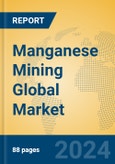Market Size and Growth Forecast
The manganese mining market is anticipated to reach USD 17-20 billion by 2025, with a CAGR of 0.5%-1.5% through 2030, driven by steady steel production needs and limited supply expansion.Regional Analysis
Africa, led by South Africa, expects growth of 0.5%-1.5%, bolstered by its dominant seaborne supply role, with trends showing resilience despite global declines. Oceania, primarily Australia, anticipates growth of 0.2%-1%, recovering from 2024’s cyclone impact, with a focus on export recovery. Asia Pacific projects growth of 0.5%-1.5%, with China’s steel demand driving imports, though domestic mining is limited. Gabon expects growth of 0.2%-1%, constrained by operational setbacks.Application Analysis
- Metallurgy: Projected at 0.5%-1.5%, this dominates due to steel production, with trends toward higher-grade ores for efficiency.
- Chemicals: Expected at 0.2%-1%, used in fertilizers and batteries, with slow growth tied to niche applications.
Key Market Players
- South32: An Australian firm, South32 leads in manganese mining globally.
- Consolidated Minerals: A major player, it focuses on manganese in Australia and Ghana.
- Anglo American: A UK-based firm, it integrates manganese with its metals portfolio.
- South Manganese Group: A Chinese company, it targets domestic steel needs.
- ERAMET: A French firm, ERAMET excels in manganese mining in Gabon.
- Vale: A Brazilian giant, Vale supplies manganese regionally.
- African Rainbow Minerals: A South African firm, it leverages rich deposits.
- Jupiter Mines: An Australian company, it focuses on manganese exports.
- Kudumane Manganese Resources: A South African player, it supports local supply.
- Western Region Gold: A Chinese firm, it explores manganese opportunities.
- Ningxia Tianyuan Manganese: A Chinese leader, it dominates regional production.
Porter’s Five Forces Analysis
- Threat of New Entrants: Low. High capital and resource concentration deter entry.
- Threat of Substitutes: Low. Manganese’s steel role lacks direct alternatives.
- Bargaining Power of Buyers: Moderate. Steel makers have leverage, balanced by supply limits.
- Bargaining Power of Suppliers: High. Few producers control output.
- Competitive Rivalry: Moderate. Key players compete on volume and quality.
Market Opportunities and Challenges
Opportunities
- Steel Demand: Stable carbon steel production sustains need.
- Battery Growth: Manganese’s role in batteries offers potential.
- Emerging Markets: Africa holds untapped reserves.
- Supply Recovery: Post-2024 rebound opportunities exist.
- Efficiency Gains: Technological advances boost yields.
Challenges
- Supply Volatility: Weather and shutdowns disrupt output.
- Environmental Regulations: Stricter rules raise costs.
- Ore Grade Decline: Lower quality impacts profitability.
- Economic Sensitivity: Steel cycles affect demand.
- Capital Constraints: Limited investment slows growth.
This product will be delivered within 1-3 business days.
Table of Contents
Companies Mentioned
- South32
- Consolidated Minerals
- Anglo American
- South Manganese Group
- ERAMET
- Vale
- African Rainbow Minerals
- Jupiter Mines
- Kudumane Manganese Resources
- Western Region Gold
- Ningxia Tianyuan Manganese








